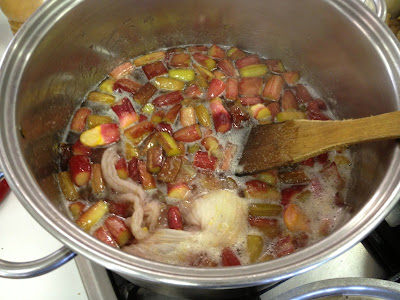(to read Brian’s take on the day, go to: http://omotic.blogspot.ie/)
Pig in a Day!
 |
| Mom and offspring separated by a fence. "House" in the background. |
Close to the source… close to the ground .. close to the bone. We learn, we experience, we taste, we get our hands less than pristine. We channel our grandparents and great grandparents in their everydayness of making life work – of getting by – of giving and getting from the land.
 |
| yep... this was the size that was our subject for the day. |
So that’s what we do here. The learning curve is different for each of us on this Saturday, as folks from other parts of Ireland (including several now raising pigs), two American college students (who literally flew in for this class), a French ex-pat, two cookery students (I’m one), and Brian all assemble to see the process of parting out (“fabricating”, though they don’t use that term here) the animal and then preparing it.
 |
| Darina Allen orientating our group to raising organic pig farming. |
First Darina (the progenitor of all things Ballymaloe and the Irish food movement), leads us out to the pig field (for lack of a more correct term). Years ago they started out with three heritage varieties (no notes here, so can’t elucidate you). However, with the disease that swept through here a few years back, they could not bring in any more pigs, so decided to inbreed what they had. They feed their pigs a wide variety of things. But there is Irish law that prohibits pigs who will be fed to the public from getting “scraps.” Silly law, as pigs and humans should live in a symbiotic relationship of one using the other’s leftovers very efficiently. Evidently the pigs are fed and adore comfrey and seaweed which are really good for them.
 |
| Look carefully. See that squared-off section of dirt? The pigs did that... very neatly and intuitively. Smart piggies! |
The pig we would be “appreciating” throughout the day had been slaughtered 5 days before, and was probably 4-5 months old. Normally, they would want a pig a few months older and hung for up to two weeks. Adult pigs and their progeny were really friendly. They have “houses” … and root in the grass very neatly (actually a straight square)! Imagine! Brilliant! As Darina says, these pigs have a wonderful life: they live outdoors, root to their hearts’ content, would put the local vet out of business if he only had them to rely on as they never get sick, and they enjoy each other! Then they have a lovely ride to town, have a sleep over with other pigs to relax, and then it's piggy heaven.
 |
| Phillip Dennhardt readies the piggie on the board. |
Our instructor for the day would be Darina’s son-in-law Philip Dennhardt, who is originally from Germany. He met Darina’s daughter in New York where he was working as a butcher (he’s 5th generation butcher, who completed his 3-year butchery apprenticeship in Germany and then returned to do his masters which is very difficult). He is a great teacher and obviously loves what he does -- as well as a great believer in following the natural lines of separation in the pig and only used the saw to go through the ribs (interesting that a butcher’s saw has the teeth going forwards instead of backwards). His knife of choice was a 6-inch semi-rigid filleting knife.
 |
| The piggie now parted out. |
Philip talked about growing up around his father’s business - nothing was wasted. At age 10, his father would have him scrape the meat between the bones, telling him, “It’s the little bits that determine at the end of the year what car you buy!” Men who brought their animal to the abattoir (kill area), would actually follow their animal down the line to make sure they got their animal in the end. A big thing here in Ireland is “black pudding” made from all sorts of things including blood. However, there is Irish law against using the actual fresh blood, so they have to use “dried blood” instead (now really… which is worse?). Again.. several in the class were interested in being able to get their own fresh pig’s blood to make their own puddings!
 |
| Stuffing sausage! |
During the class time (9:30am – 5pm), Phillip used every part of the animal, except the ear (yes, he knows there are folks who love deep-fried ears), the tail, the adrenal glands, and the “squeal” as my American chef-instructor used to say!
In the process, there were six receptacles: scrap for the chickens, stock, fat for lard, offals, skin for chitlins (there is probably an Irish term), and meat for sausage. And of course all the pieces to be cooked were laid out. The variety of dishes he prepared with an assistant was amazing: head cheese, terrine, roast and stuffed pork, chops, 4 kinds of sausage, chitlins.
Here they call “pork” pig meat that is uncured, and “bacon” is anything cured. “Bacon” as WE know it is called “streaky bacon.” So confusing!! Interesting that sea salt has a level of natural nitrites in it…. So that when meat is cured with it, there will be a slight pink ring.
 |
| That's head cheese in the foreground and chitlins in the background. |
The recipes that were made for us were: Brawn (head cheese) -- Pork, Spinach and Herb Terrine -– Ballymaloe Homemade Sausages -- Beerfest Sausage -- Philip Dennhardt’s Homemade Frankfurters – Salami – Chorizo -- Roast Stuffed Loin of Pork with Crackling & Brambly Apple Sauce. It was an inspiring day.
Brian thinks he’s up to getting a half pig and cutting it up when we return home. I told him as soon as the garage is organized.
















